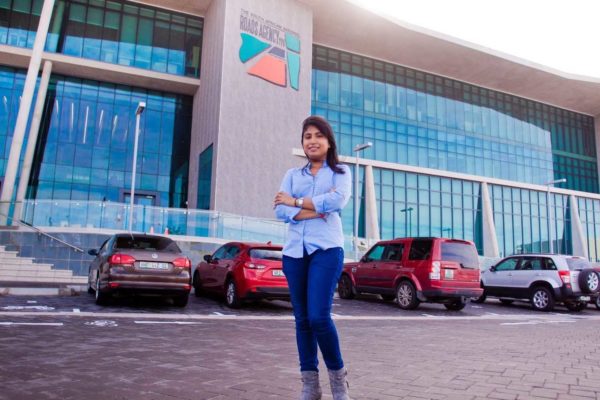SANRAL is influential in empowering women in construction and engineering.

At the age of 24, Kerisha Govender is one of the shining lights at the South African National Roads Agency (SOC) Limited (SANRAL). She obtained a SANRAL bursary to study at University of KwaZulu-Natal and graduated with a BSc in Civil Engineering (with Honours) in 2014.
Kerisha started working for SANRAL the following year. “I started my career as a civil engineer firstly by being seconded to a consultant to gain site experience. I worked on the Mount Edgecombe Interchange Upgrade project in KwaZulu-Natal from 2015 to 2016.
“My role on the project was Assistant Resident Engineer. I worked with structures – bridges, retaining walls, mechanically stabilised earth walls – and road works. In 2017 I moved to the SANRAL Design Training Academy in Port Elizabeth to be involved in the planning and design process of road infrastructure. I am currently involved in geometric design, tender procurement processes and traffic planning and analysis.”
What drew you to civil engineering? What did you hope to learn?
“From a young age I have been fascinated with the systems of transportation, with major structures and construction works such as major interchanges and buildings, like those in Dubai and Malaysia.
“I always wanted to know how the interchanges worked, what planning and design was required to ensure the fluid flow of traffic, how did railway systems work, how did metro public transport work, what kept structures up, how did bridges span across such large distances? How? Why? Where? When? These constant questions grew in complexity and magnitude as I grew up and was exposed to more information regarding Civil Engineering. So, in 2011, I began my studies towards a BSc Degree in Civil Engineering.”
What’s the most interesting thing you’ve learnt in your curriculum this semester?
“Despite obtaining my BSc degree in Civil Engineering (with honours), the questions did not stop. Thanks to the opportunities provided to me by SANRAL, I developed more interests in the specialist fields of Civil Engineering and my questions increased significantly in terms of complexity and focus.
“So, I took the next step. I applied to join a Master’s in Engineering Programme in Transportation Engineering at the University of Stellenbosch in 2017. SANRAL supported my desire to specialise in the field of Transportation Engineering and encouraged me to further my studies.
“I was also granted a full bursary, which covers my Master’s Degree. My first block module, as part of my Master’s programme, was Transport Economics. The course helped me understand how construction projects were evaluated in terms of whether they were viable or not. This was dependent on the amount of benefits that each alternative of the project generated.
“With this course I gained first-hand exposure as to what needs to be considered and calculated to develop and carry out an economic analysis for a project. I was also exposed to how the results of the calculations are to be interpreted and what those results indicated.”
Have you learned about blasting in your curriculum yet? What is it and when would engineers have to perform controlled blasts?
“In my experience as a Civil Engineer thus far, I have not been directly involved in controlled blasting. My knowledge regarding the topic is that it is a complex activity that needs to be monitored carefully in order to ensure that it runs smoothly. If the necessary precautions are not taken, there could be disastrous effects.
“For example, if too much explosive is used, then the supporting structures or other infrastructure associated with the project could be damaged or weakened significantly. Controlled blasting is done when the blasting works need to be carried out near existing infrastructures such as roads and bridges.”
Where do you see yourself in 10 years?
“I hope to have achieved my current goals, which are: to be registered as a Professional Engineer with ECSA, to have my Master’s Degree in Transportation Engineering and to be a Specialist Project Manager.”

